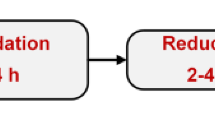Abstract
Here we report on a single-step, eco-friendly, and facile approach to combustion-assisted reprocessing of oily copper waste into copper powder without preliminary cleaning. Complete reduction of copper from oily copper waste in the combustion wave was reached in the presence of ammonium nitrate and without introducing any reducing agent. The optimal conditions for obtaining >99 % copper powder were reached for green [Cu2O + m(oil)] + xNt mixtures with m = 7–11 wt % and x = 0.35–0.55, were m stands in wt % and x in mole fractions, both in relation to 1 g-mol of Cu2O. In scale-up experiments (up to 10 kg of green mixture), the copper powder with oxygen content below 0.5 wt % and free carbon content below 0.25 wt % was successfully produced. Our approach was also successfully applied to combustion-assisted reduction of copper oxide oily waste mixed with nickel oxide to yield composite powders and Cu–Ni alloys.







Similar content being viewed by others
REFERENCES
Slade, M.E., An Econometric Model of the US Copper and Aluminum Industries: How Cost Changes Affect Substitution and Recycling, London: Routledge, 2018, chs. 3–4. https://doi.org/10.4324/9781351140362
Agrawal, A., Kumari, S., and Sahu, K.K., Iron and copper recovery/removal from industrial wastes: A review, Ind. Eng. Chem. Res., 2009, vol. 48, no. 13, pp. 6145–6161. https://doi.org/10.1021/ie900135u
Sheih, Sh.-W. and Tsai, M.-Sh., Hot water separation process for copper and insulating material recovery from electric cable waste, Waste Manage. Res., 2000, vol. 18, no. 5, pp. 478–484. https://doi.org/10.1034/j.1399-3070.2000.00150.x
Lebukhova, N.V. and Karpovich, N.F., Carbothermic reduction of copper, nickel, and cobalt oxides and molybdates, Inorg. Mater., 2008, vol. 44, no. 8, pp. 890–893. https://doi.org/10.1134/S0020168508080207
L’vov, B.V., Mechanism of carbothermal reduction of iron, cobalt, nickel, and copper oxides, Thermochim. Acta, 2000, vol. 360, no. 2, pp. 109–120. https://doi.org/10.1016/S0040-6031(00)00540-2
Handbook of Non-Ferrous Metal Powders: Technologies and Applications, Neikov, O.D., Naboychenko, S.S., and Dowson, G., Eds., Amsterdam: Elsevier, 2009, ch. 16.
Merzhanov, A.G., History and recent developments in SHS, Ceram. Int., 1995, vol. 21, no. 5, pp. 371–379. https://doi.org/10.1016/0272-8842(95)96211-7
Merzhanov, A.G., The chemistry of self-propagating high-temperature synthesis, J. Mater. Chem., 2004, vol. 14, pp. 1779–1786. https://doi.org/10.1039/B401358C
Yamukyan, M.H., Manukyan, Kh.V., and Kharatyan, S.L., Copper oxide reduction by combined reducers under the combustion mode, Chem. Eng. J., 2008, vol. 137, no. 3, pp. 636–642. https://doi.org/10.1016/j.cej.2007.05.033
Kharatyan, S.L., Manukyan, Kh.V., and Yamukyan, M.H., Reduction of copper oxide in combustion mode by means of C–H–O–N combined reducers, Abstr. VII Int. Symp. on SHS, Krakow, 2003, p. 60.
Concise Encyclopedia of Self-Propagating High-Temperature Synthesis, Borovinskaya, I.P., Gromov, A.A., Levashov, E.A., Maksimov, Y.M., Mukasyan, A.S., and Rogachev A.S., Eds., Amsterdam: Elsevier, 2017, pp. 196–197.
Merzhanov, A.G., Thermally coupled SHS reactions, Int. J. Self-Propag. High-Temp. Synth., 2011, vol. 20, no.1, pp. 61–63. https://doi.org/10.3103/S1061386211010109
Kharatyan, S.L. and Merzhanov, A.G., Coupled SHS reactions as a useful tool for synthesis of materials: An overview, Int. J. Self-Propag. High-Temp. Synth., 2012, vol. 21, no. 1, pp. 59–73. https://doi.org/10.3103/S1061386212010074
Kharatyan, S.L., Metal powders by SHS: Application of organic compounds as effective reducers, Abstr. X Int. Symp. on SHS, Tsakhkadzor (Armenia), 2009, pp. 62–63.
Mahmoudi, H.A., Abovyan, L.S., and Kharatyan, S.L., SHS processing of copper waste into copper powder, Chem. J. Armenia, 2017, vol. 70, no. 4, pp. 477–486. http://chemistry.asj-oa.am/7829/
Yamukyan, M.H., Manukyan, Kh.V., and Kharatyan, S.L., Obtaining nickel powder by reduction of basic nickel carbonate under the combustion mode, Chem. J. Armenia, 2008, vol. 61, no. 2, pp. 159–166. http://chemistry. asj-oa.am/783/
Author information
Authors and Affiliations
Corresponding authors
About this article
Cite this article
Mahmoudi, H.A., Abovyan, L.S., Aydinyan, S.V. et al. SHS Reprocessing of Copper Oxide Waste into Copper Powder. Int. J Self-Propag. High-Temp. Synth. 28, 233–238 (2019). https://doi.org/10.3103/S1061386219040095
Received:
Revised:
Accepted:
Published:
Issue Date:
DOI: https://doi.org/10.3103/S1061386219040095




